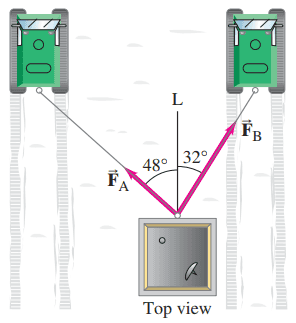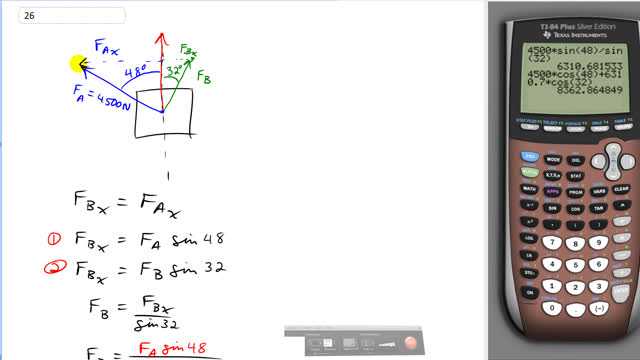
Two snowcats in Antarctica are towing a housing unit north, as shown in Fig. 4–50. The sum of the forces and exerted on the unit by the horizontal cables is north, parallel to the line L, and . Determine and the magnitude of .


In order to watch this solution you need to have a subscription.
This is Giancoli Answers with Mr. Dychko. Since the resultant force of these two arctic cats is along this line that's labeled l in the textbook, that means the X component of the force exerted by cat A, is equal to the X component of the force exerted by cat B. I guess you can't really see that based on my drawing but this is meant to be the same length as this one. And knowing that we can figure out what the size of force B is because we know the angle is 32 here and the angle is 48 over here. And so, X component of force B equals X component of force A. And X component of force B can be written as FA times sine 48. This is making a substitution for FAx sine because this leg is the opposite leg of this triangle. So, you sign to get it. And you can also say that FBx equals FB times sine 32 because FBx is the opposite leg of this triangle. And then solve or rearrange F2 for FB or equation 2 for FB divided by sine 32. So, FB is FBx divided by sine 32. But from Equation 1 we know that FBx is sine of 48 times FA and so we'll write that in place of FBx here. And so, we made a substitution into that equation to get to the next line. And we have 4500 Newtons for force A times sine 48. And then divide by sine 32 means the force exerted by arctic cat B is 6300 Newtons with two significant figures. And the resultant force here along the red line is going to consist of only the Y components of FA and FB because the X components of those two arctic cats is equal in order to have the house being moved along a straight line. If the x components were not equal, the house would be moving to the sides. So FA times cos 48 gets the y component of force A. And then Fb times cos 32 gets the component along this red resultant for force B, and then those together to get the total length of the resultant. So, that's 4,500 Newtons times cos 48 plus 6310.7 Newtons times cos 32. And we get 8400 Newtons with two significant figures for the length of the resultant.
I still don't understand why FxA = FxB in this problem. With similar problems in chapter 3 the vector components were never equal unless the angles were equal. Please explain what in this problem specifically leads to knowing that FxA = FxB. Thank you!
Hi msmgel, thanks for the question. This problem says the sum of the forces is straight up. Put in other words, this means the net force is straight up. The only way for that to be possible is if the horizontal components of and are of equal magnitude in opposite directions.
Hope that helps,
Mr. Dychko